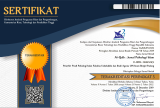Reseliensi Warga Desa Pendung Talang Genting Pasca Konflik Dengan Warga Desa Sleman Kabupaten Kerinci
Abstract
Keywords
Full Text:
PDFReferences
Acciaioli, G. (2001). Grounds of Conflict, Idioms of Harmony: Custom, Religion, and Nationalism in Violence. Indonesia, 72(Oct), 81–114.
Al-Krenawi, A., & Kimberley, D. (2016). Palestinian youth and their families in an area of conflict, stress and trauma. Public Health: Some International Aspects, 7(2), 81–96.
Alganih, I. (2016). Konflik Poso (Kajian Historis Tahun 1998-2001). Criksetra: Jurnal Pendidikan Sejarah, 5(2), 166–174.
Centre for Humanitarian Dialogue. (n.d.). Conflict Management Strategies in Indonesia : Learning from the Maluku Experience Workshop report.
Driver, M. (2011). Positively Positive Psychology, 1–146.
Grotberg, E. (1995). A guide to promoting resilience in children: strengthening the human spirit. Early Childhood Development: Practice and Reflections. Retrieved from http://resilnet.uiuc.edu/library/grotb95b.html
Kahija, L. (2017). Penelitian Fenomenologis. Yogyakarta: Kanisius
Pruitt, D. G., & Rubin, J. Z. (2004). Teori konflik sosial. Yogyakarta: Pustaka Pelajar.
Ract, A. B. S. T. (2013). Kolaborasi Menuju Resiliensi :, 2(1), 1–14.
Reivich, K & Shatte, A. (2002). The Resilience Factor: 7 Keys to Finding Your Inner Strength and Overcoming Life’s Hurdles. New York: Three Rivers Press.
Ruswahyuningsih, M. C., & Afiatin, T. (2015). Resiliensi pada Remaja Jawa. Jurnal Psikologi UGM, 1(2), 96–105. https://doi.org/10.22146/gamajop.7347
Sataloff, R. T., Johns, M. M., & Kost, K. M. (n.d.). No 主観的健康感を中心とした在宅高齢者における 健康関連指標に関する共分散構造分析Title.
Semedhi, B. P., Lestari, S., & Hasanah, N. (2015). Resiliensi Pengungsi Korban Sampang. Mediapsi, 01(01), 51–58. https://doi.org/10.21776/ub.mps.2015.001.01.6
Tajfel, H. (1982). Social psychology of intergroup relations of intergroup relations. England: Departement of psychology, University of Bristol.
Refbacks
- There are currently no refbacks.
Ruang Jurnal,
Fakultas Ushuluddin dan Studi Agama,
UIN Imam Bonjol Padang
Jl. Mahmud Yunus No.6,Lubuk Lintah,
Kota Padang, Sumatra Barat
E-mail: jurnal-alqalb@uinib.ac.id

This work is licensed under a Creative Commons Attribution-ShareAlike 4.0 International License.



